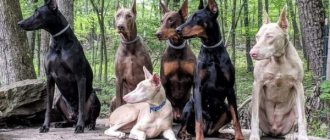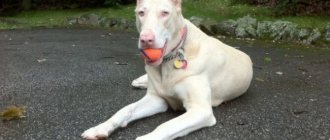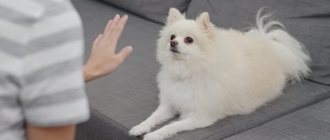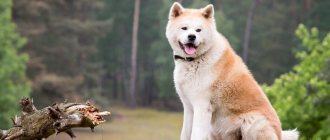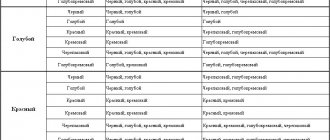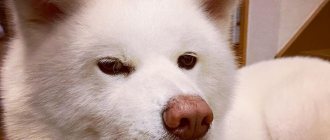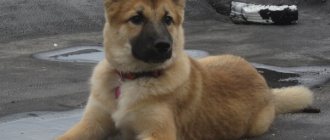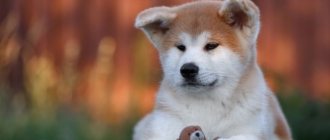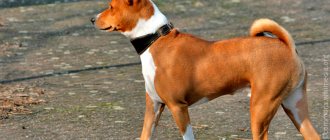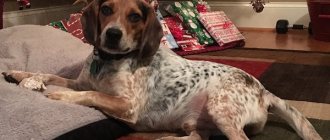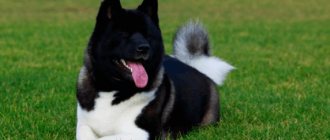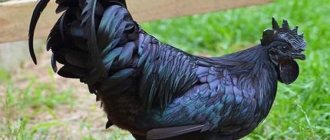Color is a canine term that refers to the color of a dog's coat. It is one of the most important traits when breeding dogs. The standard of any breed establishes acceptable and unacceptable colors. Dogs can surprise you with their colors. Each breed of dog has its own color and pattern, therefore, trying to find a puppy with an uncharacteristic color for a given breed is a pointless exercise.
Akita Inu is a brave and loyal friend from Japan. This is a self-sufficient dog breed with high intelligence. In Japan it is a symbol of devotion, love, family happiness and financial wealth. When training, owners need to show firmness and perseverance.
- Country of Origin : Japan
- Height at withers : male: 67 ± 3 cm female: 61 ± 3 cm
- Weight : 40-50 kg
- Lifespan : 10-14 years
- Use : Companion Dog, Guard
- Other names : Japanese Akita, Akita, large Japanese dog
Color classifications
There is no consensus in the canine community about the acceptable colors of Akita Inu. The World Canine Organization allows only four:
- brindle;
- snow-white;
- red-fawn;
- sesame.
Other organizations have their own versions. AKIHO accepts the following colors of Japanese Akita:
- white;
- redhead;
- spotted;
- black;
- brindle;
- sesame.
According to NIPPO, there are only 5 variations:
- white;
- black;
- sesame;
- redheads;
- brindle.
AKIKIO allows the following suits of “Japanese huskies”:
- black;
- sesame;
- white;
- ginger;
- brindle.
Another common classification of breed colors:
- "Red Urajiro." “Fox” is red with characteristic white markings on the cheeks, lower jaw, muzzle, neck, chest, abdomen, and inner parts of the legs.
- Solid snow white with black nose.
- Brindle. It is divided into three varieties: shimofuri (silver “tiger”), akatora (red, red tiger), kurotora (black “tiger”).
In the homeland of the breed, Japan, the traditional “fox” color of the Akita is valued.
Lifespan and immune system
Akita Inu lives quite a long time, about 10-15 years. Diseases Akita Inu has good health, but like many others, there are weaknesses:
- Joints . Problems may appear in the form of dysplasia, which can lead to inability to move. It causes severe pain in the joints. The disease is mainly genetic. Sick individuals are not bred.
- Von willebrand blood disease (similar to hemophilia in humans).
- Inverted eyelid. There is an inversion of the eyelid edge inward and outward. A genetic defect. In this case, surgery is needed.
- Gastric volvulus . The disease is acquired in case of frequent overeating and low activity of the animal. The likelihood of the disease occurring depends on the dog’s weight. To prevent it, you need to monitor your diet and serving size at a time. The animal should be fed 2-3 times a day in small portions.
- Eye diseases - cataracts, glaucoma, etc.
White color
White Akita Inu are still a rarity in Russia. But in their Japanese homeland they are already widespread. This color is the youngest, it was developed only at the beginning of the 20th century. The main feature of snow-white Akitas is the absence of even small marks or spots on the body. A yellow, grayish “patina” on the back and sides is considered a fault. But at the same time, the presence of a bluish, silver “mantle” adds points to the dog at exhibitions. These dogs are not albinos. They have dark eyes, a black or “liver” nose, black lips, “eyeliner” on the eyes - this is a standard requirement. As an exception, a light nose is allowed. But the lips and eyes should be black. White Akitas, according to owners, are more prone to allergic reactions - dogs require special food selected by a veterinarian. One of the manifestations of allergies is the appearance of yellow spots on the dog’s ears, face, and back. Photos of snow-white Akita Inu:
Advantages and disadvantages
Advantages:
- Distrust of strangers.
- Fearlessness.
- Reliable defender.
- Ability to educate.
- Devotion.
- Longest life expectancy among dogs of this size.
- They don't bark that much unless it's necessary.
- They can live both in a private house on the street and in an apartment.
- Cleanliness, neatness.
- They eat in moderation.
- Each puppy has a distinct personality.
Flaws:
- Without proper training, their great strength and agility can have negative results.
- Puppies of this breed do not accept training through force; they need to be approached with love and affection.
- Quite aggressive towards other large dogs, especially males.
- There may be problems with molting, because... They have it quite strong and happens 2 times a year. But with the right care, the problem disappears.
Red Akita Inu
Red is the traditional, most common color of the Akita Inu. The color of the “mantle” is allowed from pale beige to almost fiery red. In this case, a white shirtfront, cheeks, bottom of the muzzle, belly, and inner parts of the legs are required. There may be light marks on the neck. Dark “masks” on the face of the “Japanese husky” are unacceptable. But for American Akitas, this feature is not a disadvantage of the breed. The legendary Hachiko was precisely red-fawn in color. Akitas like these are some of the most spectacular, especially the fiery red dogs. Color develops with age - newborn puppies are almost gray and black. From about 3 months, the color begins to change to a permanent one. Photos of red Japanese Akitas:
Black
In fact, it is very rare . Most often, this color, when viewed more carefully by a professional eye, is classified as black sesame or brindle without a clear stripe pattern.
Please note that three out of four existing standards accept this color, since since ancient times it has been customary to depict national pride in black and white.
Considering the age of the breed, it can be assumed that many of the drawings were created during that period of the historical development of mankind, when multi-colored drawings were impossible.
Sesame Akita Inu
This color is becoming rare nowadays, even in the 50s. 20th century was the most common among Akita Inu representatives. This is a red “mantle”, but with a peculiar black “belt” on the back and a snow-white bottom. As for red representatives, the white underside is important here - the chest, belly, inner parts of the paws, tail, cheeks and lower jaw. Everyone sympathizes with Kadyrov’s grief: the sad news shocked people Scandal on Channel One: a famous presenter turned out to be a man who had changed his sex Scientists have discovered a frightening feature in everyone who died from COVID-19: Today, sesame color is practically not involved in selection. In the Japanese homeland of the breed, it is no longer popular; in Russia there are practically no such dogs. Due to the similarity of colors, these representatives of the breed were often called “Japanese Shepherds.” Pictured are sesame Akita Inu:
A little history
Akita, Inu is ranked among the fourteen oldest dog species in the world. Scientists made this decision based on DNA tests, a thorough study of the ancestry of our heroes, and also thanks to the rock paintings found. Our heroes are unofficially called the Japanese Laika. Firstly, because they are from Japan, and secondly, because they really have a lot in common, although this species belongs to the Spitz group.
Until the seventeenth century, the Japanese husky served ordinary people and helped them in hunting, guarded the house, herded livestock and even took part in dog fights. It is worth noting that in those days the breed was much smaller than today. In order for the Akita to look impressive as a fighter, and for the spectacle to become even more entertaining, they began to crossbreed it with mastiffs. The result was a variety called "matagi".
In the eighteenth century, the Akita became a privileged dog , and only high-ranking and noble people were allowed to keep it. And the point is not even that the Akita’s appearance can be considered the standard of canine beauty, but that they are talented and naturally gifted hunters. In addition, they are smart enough to be easily trained and work harmoniously as a team with their owner, lying in wait for prey. The status of the Akita rose to the imperial level.
During the Second World War, the breed practically disappeared due to their conscription to the front. Under pain of execution, many owners hid their pets and thereby gave cynologists the opportunity in the post-war period to restore an almost extinct species. During the same period, experiments on crossing with the German Shepherd took place. A new variety appears - the shepherd dog.
American soldiers, returning home from the war, took incredibly cute puppies home with them. Subsequently, American cynologists will develop a new variety called “American Akita” . It is larger, and it is this species that is most common in Russia. According to existing criteria, the maximum height of a pet does not exceed seventy centimeters.
To read: Varieties of color in the Abyssinian cat: wild color, fawn and other rare colors
Marriage or breed?
According to the breed standard, which was approved in 2001, Akita Inu belong to the fifth group called “Spitz and primitive breeds” and the fifth section “Asian Spitz and related breeds”. The appearance of these dogs is quite expressive, they are even included in the list of the most beautiful dogs in the world.
There are 4 types of dog colors:
- White.
- Brindle.
- Red or fawn.
- With dark fur tips.
IMPORTANT!
Purebred Akita Inu of all types are characterized by 3 layers of coat - the top is coarse, the hard short coat and the softest and fluffiest coat at the base. It is this coat structure and its length that influence the dog’s appearance and determine the breed standard.
What do the puppies look like?
It's impossible not to fall in love with an Akita Inu puppy at first sight. They look like little teddy bears - the dream of every child and adult.
Puppies born from red parents 2-3 weeks after birth can have all possible shades of sand color - from completely gray to intensely red. Over time, the color changes into different shades of red, from fawn to red. There may be black tips of hair on the back and at the end of the tail. These hairs usually shed during the first adult moult.
Brindle puppies do not change much the color they are born with. Whites may change color slightly - a few cream spots may appear on the tips of the ears, and cream may appear on the back.
Initially, puppies' ears hang down; they stand up at about 2-4 months. If the ears do not stand up before the teeth change, the process may be delayed, since hardening of the ear cartilage requires calcium, which goes to the teeth. In this case, the ears may rise asymmetrically, one may be ahead of the other. When they stand up completely, symmetry is restored.
Puppies' tails resemble a small donut. The paws are soft and fluffy. The general build of the puppy is plump and round. Gradually the dog will stretch out and become slimmer.
Rules of care
Akita Inu are not picky about their care, but they require compliance with certain features in the organization of their life , in which they are as comfortable as possible. First of all, this concerns food. Due to the fact that the dogs are of original Japanese origin (although they can be purchased in any other country), their bodies have an evolutionary intolerance to fatty meats.
Their digestive system is fully adapted to the following foods:
- rice;
- fish;
- seafood;
- vegetables;
- fruits.
Mostly their menu should consist of these food ingredients. But, since the breed has adapted over time to new countries and living conditions, the menu may also include:
- veal, lean beef;
- chicken;
- cereals: buckwheat, millet, pearl barley;
- low-fat broths;
- dairy products: fermented milk, cottage cheese, cheese.
The following ingredients are prohibited::
- flour products: pasta, bread, rolls, pies;
- lard, fatty meat;
- sweet.
Note!
Dry food is also strictly prohibited for use - the dog’s gastrointestinal tract can be seriously damaged. The only available way to use it is to soak it in a small amount of milk or water.
In addition to the daily diet, it is recommended to conduct seasonal courses of therapy with multivitamin and microelement complexes. Mainly, the Akita Inu's daily diet should consist of carbohydrates, protein is required no more than 20%.
As for walks, Akita loves them very much, preferring long ones. The dog should be allowed to run without a leash at least once a week in order to relieve the accumulated stress from life at home. Sometimes you can practice active games.
